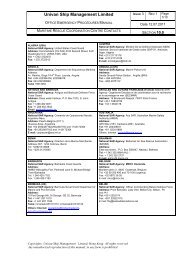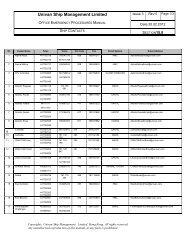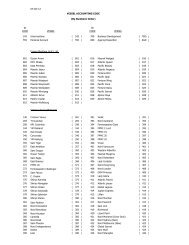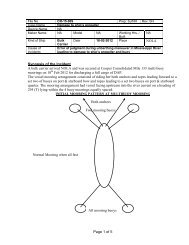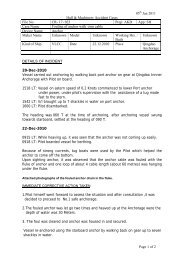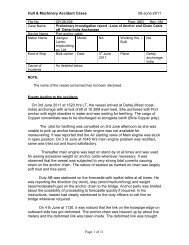Section: 11 CARGO OPERATIONS - Univan
Section: 11 CARGO OPERATIONS - Univan
Section: 11 CARGO OPERATIONS - Univan
You also want an ePaper? Increase the reach of your titles
YUMPU automatically turns print PDFs into web optimized ePapers that Google loves.
<strong>Univan</strong> Ship Management Limited Issue 1 REV 0 Page<br />
4/8<br />
FLEET OPERATION MANUAL Date 01.01.2005<br />
CONTAINER TYPES AND ASSOCIATED PROBLEMS<br />
Copyrights: <strong>Univan</strong> Ship Management Limited, Hong Kong. All rights reserved<br />
Any unauthorized reproduction of this manual, in any form is prohibited<br />
SECTION <strong>11</strong>.7<br />
a TEU and 26-27 MT for a FEU, and this gives maximum gross weight of 22 MT and 30-31 MT<br />
respectively.<br />
The variation in standards can be a problem in itself, particularly for the liner operator offering a<br />
door to door service, since the various modes of transport must be capable of carrying the<br />
container. For the ship itself, container handling gear may need changing and stowage problems<br />
can arise.<br />
<strong>11</strong>.7.3 General Purpose Containers<br />
As the name suggests, these closed containers are suitable for most types of general cargo, and<br />
temporary modification can allow carriage of solid and liquid bulk cargoes. Design and<br />
construction are basic - a metal box, with full width doors at one end and a wooden flooring.<br />
Lashing points are provided, usually with a Safe Working Load of 2 MT each. Cubic capacity for a<br />
TEU is 33.3 cbm and for a FEU is 66.9 cbm.<br />
The main problem peculiar to this type of container is ventilation when vents/fans are not fitted.<br />
Such containers are not entirely suitable for moisture sensitive cargoes, particularly on voyages<br />
from warm to colder climates. On such voyages, sweat can develop on the inner container<br />
surfaces and to prevent contact with the cargo, sheathing on such surfaces and waterproof<br />
coverings on the cargo are essential. Other problems are similar to those for general cargo<br />
carried in a vessel’s holds, and if the carrier is responsible for stuffing due regard must be given<br />
to dangers such as tainting, crushing and shifting.<br />
<strong>11</strong>.7.4 Open Top Containers<br />
This general purpose container without a roof is commonly used for over-height goods and<br />
machinery and timber requiring top loading. The door end may also be removable to allow end<br />
loading. Removable roof bows can be used to support tarpaulins to the extent this is possible with<br />
over-height cargo. Other details are similar to those for general purpose containers.<br />
These containers can be more prone to structural failure than other containers, because they are<br />
commonly used for heavier cargoes and are often subject to point loading stresses when weights<br />
have not been properly distributed. These units also create stowage problems, as stowage on top<br />
must be avoided for over-height cargoes. Shippers may request protective stows and this usually<br />
means protection from sea sprays and waves over the deck, but in any case, specific instructions<br />
should be requested and conformed with.<br />
Carriers should be particularly cautious if they are responsible for stuffing. The carrier is always<br />
expected to have a reasonable knowledge of the cargo, and accordingly, particular attention<br />
needs to be given to securing and proper weight distribution of abnormal loads. If the cargo is<br />
suspected to be moisture sensitive, and the unit has to be carried on deck, the cargo itself will<br />
need to be made suitably waterproof. Tarpaulins will inevitably allow some moisture ingress and<br />
the common problem of chafing also needs to be adequately guarded against. Again, instructions<br />
should be obtained from the shippers, and their pre-shipment approval of the stow is<br />
recommended, particularly for valuable cargoes. If tarpaulins are found to be damaged prior to<br />
shipment the shippers should be asked to make appropriate repairs, and if these are not effected<br />
the bills of lading should be suitably claused. Regular voyage inspections should pay particular<br />
attention to these units, especially the tarpaulins which may require repair and/or tightening.



